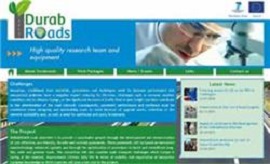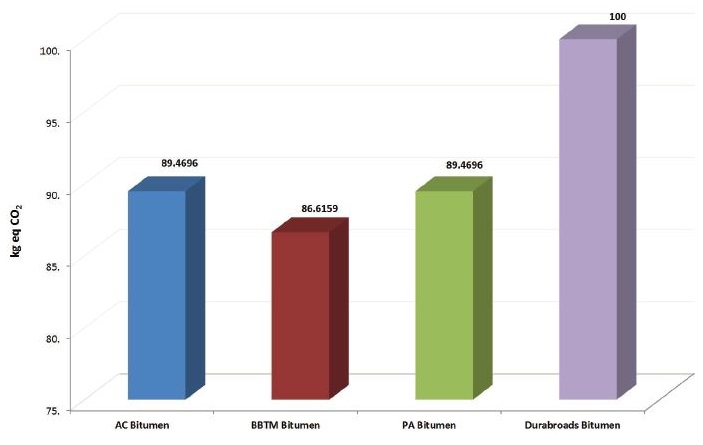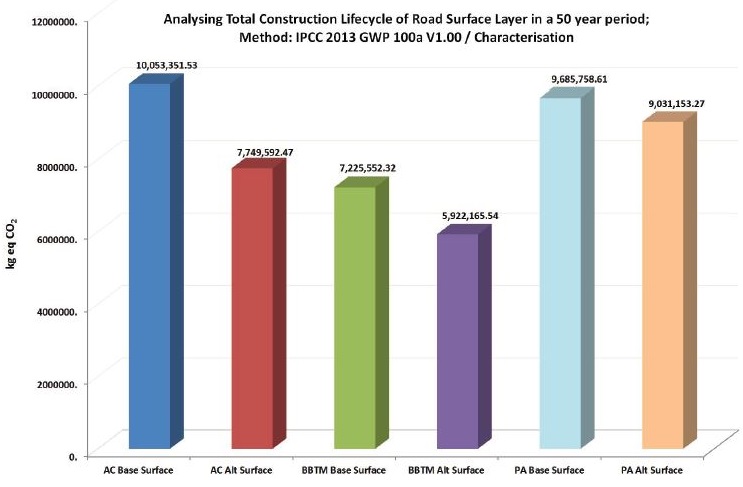DurabRoads - life cycle costing analysis
The objective of the DurabRoads project is to design, develop and demonstrate cost-effective, eco-friendly and optimised long-life roads, by means of innovative designs, and the use of greener materials.
For more information, see DurabRoads.
This article illustrates the life cycle assessment study of the bitumen mixtures undertaken by BSRIA and shows some of the results obtained so far.
BSRIA has been involved in conducting the life cycle assessment (LCA) analysis of the potential new road layer mixtures formulated by the DurabRoads project partners to quantify their environmental impacts.
For this, an analysis of the road processes was carried out including road construction, road maintenance, road relaying and recycling, using the techniques of LCA to achieve this. In the LCA analysis of DurabRoads, three pavement mixtures- PA (porous asphalt), BBTM (Béton Bitumineux Mince), and AC (asphalt concrete), were taken as the three base cases and the partners set about trying to improve their composition.
A bitumen mixture for DurabRoads (referred to as DurabRoads Bitumen here), was designed to be used with all three cases, following which the overall mixtures were also modified with different additives and steel slag and basalt as aggregates.
The LCA study was first used to gauge the environmental impact of 1kg of the bitumen mix alone for the AC, BBTM, PA and DurabRoads Bitumen mixtures. Then the environmental impact assessment of the material for each of the road systems was carried out for a unit area of 7.4 m x 1,000 m, looking at the environmental impacts for a 50-year lifecycle.
Figure 1: Comparing 1kg each of AC, BBTM, PA Bitumen Mixture and 1kg DurabRoad Bitumen Mixture
The original bitumen mixtures were compared to the new alternative bitumen mixture which is shown in Figure 1 using the IPCC method.
The IPCC method denotes the results by normalising the environmental impact into kg of CO2 equivalent. It can be seen that with the additional additives in the DurabRoads bitumen, the environmental impact of 1kg of the DurabRoads bitumen by the IPCC method is higher, making it appear worse than the currently used bitumen mixtures. However, it must be noted that this doesn’t imply that the DurabRoads bitumen must be discarded citing the higher environmental impacts as the obvious reason.
The additives and aggregates used in the DurabRoads bitumen mixture have caused the 1kg of material to have a greater environmental impact than current mixtures; however, these additives do improve the durability of the road surface, which will be able to withstand high traffic densities and adverse weather conditions for longer.
This has a direct effect on the road’s lifecycle impact. With an increased durability, the road has to be maintained and relayed less often; meaning the total quantity of material used in the lifetime of the road is reduced. As the percentage of bitumen in a road is usually quite low (around 4-5%), with aggregates comprising the highest percentage of total materials, if the durability increases by increasing or altering the bitumen content slightly, the reduction of overall environmental impact of the road is a lot more significant as the number of maintenance and relaying cycles reduces. The following figure explains this.
Figure 2: Total life cycle costing analysis of the road system over 50 years
Figure 2 shows the total environmental impact of the surface layers of each of the road systems over its 50-year lifecycle using the IPCC method where it is assumed that the DurabRoads mixture has a higher durability factor, which is considered as 1.5 times that of the original system for this analysis.
When compared against the lifecycle of the standard bitumen mixtures, the DurabRoads bitumen showed promising results by LCA. Every DurabRoads alternative showed an improvement in terms of environmental impact using the IPCC method on the standard mixtures over a 50-year lifecycle. Based on the LCA model results, the BBTM alternative surface layer has the lowest environmental impacts.
In August 2017, the results of the life cycle assessment and life cycle costing analysis of the warm mix asphalt materials were presented by BSRIA.
Divya Deepankar, Research Engineer, BSRIA Sustainable Construction Group, said:
“Based on the results obtained so far, the road layers composed of the warm mix asphalt materials have better environmental and economic performance across the life cycle of the road system studied.
Going forward, the durability factor obtained from the pilot test results of the pilot road tested in Spain will be incorporated to analyse and infer the best case. These results will be reported and presented soon."
This article was originally published in June 2017 by BSRIA.
Written by Divya Deepankar, Research Engineer, BSRIA Sustainable Construction Group.
--BSRIA
[edit] Find out more
[edit] Related articles on Designing Buildings Wiki
Featured articles and news
Latest Build UK Building Safety Regime explainer published
Key elements in one short, now updated document.
UKGBC launch the UK Climate Resilience Roadmap
First guidance of its kind on direct climate impacts for the built environment and how it can adapt.
CLC Health, Safety and Wellbeing Strategy 2025
Launched by the Minister for Industry to look at fatalities on site, improving mental health and other issues.
One of the most impressive Victorian architects. Book review.
Common Assessment Standard now with building safety
New CAS update now includes mandatory building safety questions.
RTPI leader to become new CIOB Chief Executive Officer
Dr Victoria Hills MRTPI, FICE to take over after Caroline Gumble’s departure.
Social and affordable housing, a long term plan for delivery
The “Delivering a Decade of Renewal for Social and Affordable Housing” strategy sets out future path.
A change to adoptive architecture
Effects of global weather warming on architectural detailing, material choice and human interaction.
The proposed publicly owned and backed subsidiary of Homes England, to facilitate new homes.
How big is the problem and what can we do to mitigate the effects?
Overheating guidance and tools for building designers
A number of cool guides to help with the heat.
The UK's Modern Industrial Strategy: A 10 year plan
Previous consultation criticism, current key elements and general support with some persisting reservations.
Building Safety Regulator reforms
New roles, new staff and a new fast track service pave the way for a single construction regulator.
Architectural Technologist CPDs and Communications
CIAT CPD… and how you can do it!
Cooling centres and cool spaces
Managing extreme heat in cities by directing the public to places for heat stress relief and water sources.
Winter gardens: A brief history and warm variations
Extending the season with glass in different forms and terms.
Restoring Great Yarmouth's Winter Gardens
Transforming one of the least sustainable constructions imaginable.


























